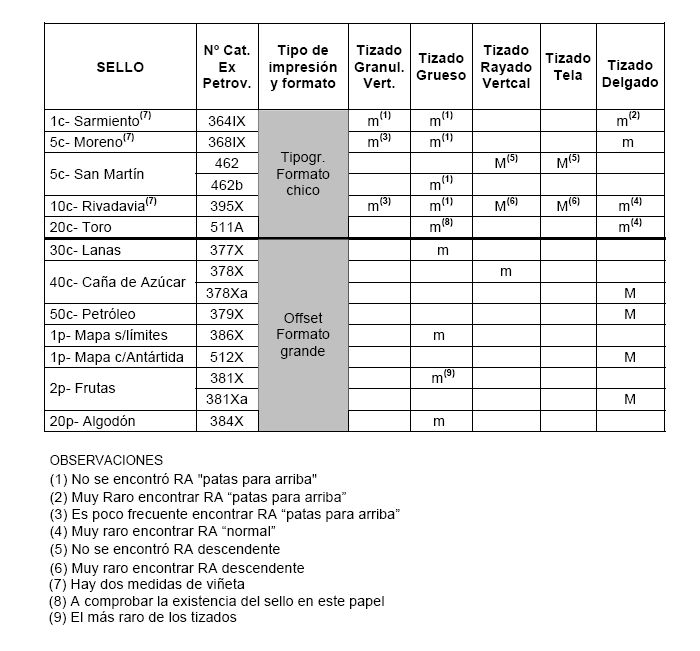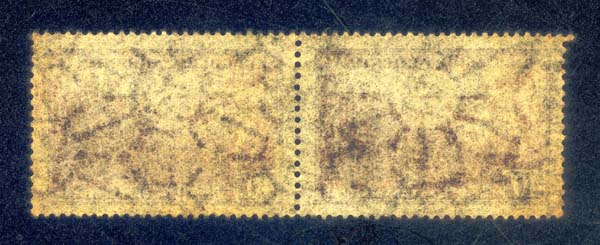2009 Notes, Publication No. 4 Plate and Printing Varieties (PDF, 18.0 MB)
5c1E1t repeatable pv's from DEPOF blocks Part 1 45 5c1E1t repeatable pv's from DEPOF blocks Part 1 details 51 5c1E1t repeatable pv's from DEPOF blocks Part 2 54 5c1E1t repeatable pv's from DEPOF blocks Part 2 details 58 10c Rivadavia Red Type I Plate Curiosities 60 10c Rivadavia Red Type II Plate Curiosities 62 10c Rivadavia Red Type II Plate Variety No 1 65 10c Rivadavia Red Type II Plate Variety No 2 68 10c Rivadavia Red Type II Inking 'eye' varieties 70 10c Rivadavia Red Type II Plate Variety 72 15c Martin Guemes 'break under first A of ARGENTINA' 74 15c Martin Guemes 1L 'Fat I in TINA of ARGENTINA' 78 15c Martin Guemes 2C 'Fat I in TINA of ARGENTINA' 80 Comparisons of the 15cMG-SO 'TINA' 89 20cSC1L1 plate variety 95 Some plate varieties of the 20cSC 97 Plate varieties on a block of the 25c1E3 103 Acid wash to the 30c plate NGR 107 A few 40cNGR plate varieties 108 Two NGR plate varieties 114 a plate variety of the 50c 116 a few plate varieties of the 50c 116 Acid wash of the 50c and 2 pesos plates in 1952 120 Plate sequence proposal for the 50c and 2 pesos values 126 Several master die plate varieties of the 50c 126 50cNGR plate variety 130 A plate variety of the 1 peso Antartica 132 2P2C minor plate varieties 133 2P2C common plate varieties 136 2P2C 'missing corner' 138 2P2C 'two scratches' plate variety 139 Plate varieties on three 2P2 blocks 142 2p1Ls with shifted center 146 2p1L plate wear 150 2p1L6 Upper Left corner block with key plate variety 152 5p2C Plate Variety 154 'Speck over palm' 5 pesos plate variety 155 5p1L2 Lower Right corner block with plate varieties 161 A 5p1L2 block showing repeated plate varieties 163 Various 5p1L2 plate varieties 166 Plate variety candidate for the 5p1L2 168 The most elusive 5p plate variety 170 10pNGR Blocks with plate varieties 172 10pNGR-SO Blocks with plate varieties 180 50cCL2B-SO 'Yellow on top' just discovered by Rein 186 5pNOP printed in reverse color order 192
2009 Notes, Publication No. 5 Postmarks, Covers, Postcards, Postal Entires and PERFINs (PDF, 14.1 MB)
25c range of use 12 Second day of issue 1935 cover 13 Brigada and Ambulante explained 15 A few 40c early postmarks 17 Buenos Aires non-standard postmarks part 1 19 Buenos Aires non-standard postmarks part 2 23 An early cover bearing the 10c Rivadavia Brown 27 Buenos Aires special use postmarks 30 The 1943 CL1B 1 peso and 2 pesos on cover 34 Late usage of the 2 pesos and 5 pesos 36 A postal entire with Census information 38 A small selection of used postcards 44 5c Postal Entires Plain Type 49 5c Postal Entires Post Horn Type 55 5c Postal Entires Post Horn in Shield Type 60 A 50c1E Perfin 62 Several 2 pesos PERFINs 63 Peculiar PERFINs 69 BE PERFIN 72 High value PERFINs 74 Perfins Selection in Alphabetical Order 75
2009 Notes, Publication No. 6 A Beginner's Collection (PDF, 8.0 MB)
1E1 cents for the Beginner's Collection 44 Early 15c and 20c stamps for the Beginner's Collection 46 5c and 10c Red for the Beginner's Collection 48 A few Clay 'cents' for the Beginner's Collection 51 1E3 'cents' for the Beginner's Collection 52 1E4 small format values for the Beginner's Collection 54 1E2 Large Format Stamps (Beginner's Collection) 57 NGR and NOP Large Format Stamps (Beginner's Collection) 60 2C High Values (Beginner's Collection) 65 Some 1L High Values (Beginner's Collection) 70 Postmarks on Selected 1E3 Stamps (Beginner's Collection) 75 Beginner's Collection close to 80 percent complete 76
2009 Notes, Publication No. 7 10cR, 20cSC, 40c and some High Values (PDF, 13.9 MB)
Comments on the new catalog by Gottig and Jalil (GJ 2009) 44 50c Departmental Official forgeries 46 5c Moreno Regular Issues 52 10c Rivadavia Red heights compared 57 10c Rivadavia Red Type I 59 10c Rivadavia Red Type II 61 Comparison of the 10c Rivadavia Red Type II and Type III 65 Relative numbers of the three types of 10c Rivadavia Red 68 'two dots' 10c Rivadavia Red Type III plate variety 69 10c Rivadavia Red Types II and III in two blocks 74 Small threads in two late papers for the 20cSC 76 The 20cSCCL2A-L Light Blue Clay 83 The 20cSCCL2A-D Dark Blue Clay 86 The 20cSC1L1 90 The 20cSC1L5z 92 Early 40c (1E1 and 1E3a) 95 Selection of 40c1E2 100 The two clay 40c printings 103 A selection of 40cNGR 109 The two major shades of the 40c2C 113 A small selection of the 40c1L6 117 The 1p2D 119 The 2p1E3b 'cream' frame 121 Colors of the 2p1L6 123 A selection of 5pNOPs 127 The 20P1L2 132 Two 20 pesos blocks 138














































